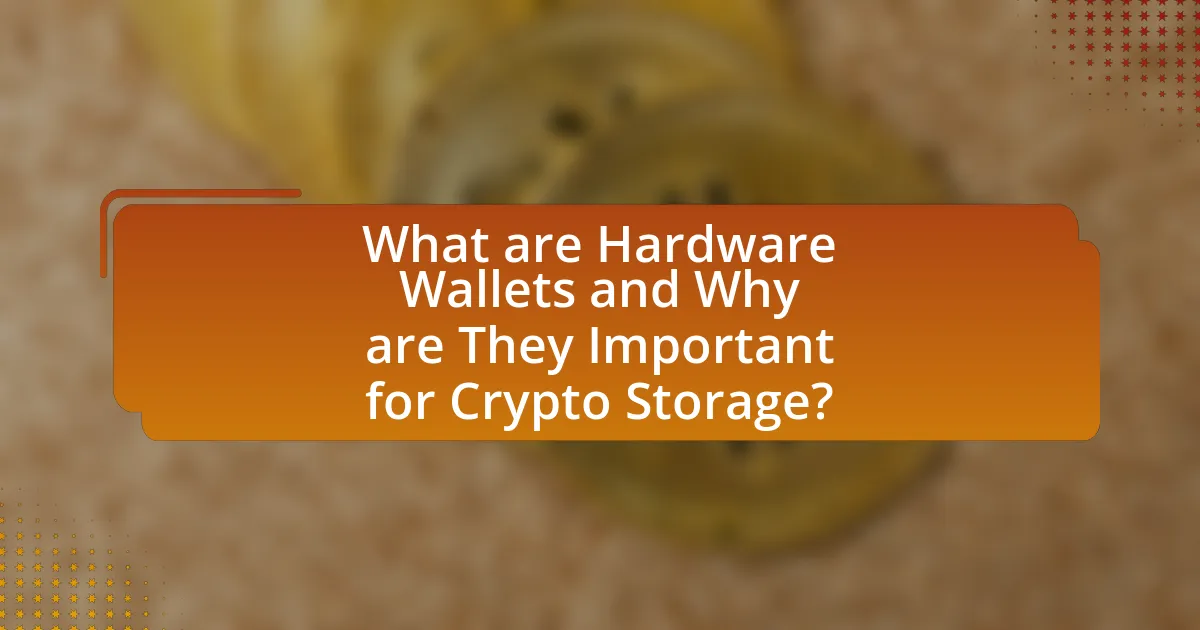Hardware wallets are physical devices designed to securely store cryptocurrency private keys offline, providing enhanced security against hacking and malware threats. This article explores the importance of hardware wallets for long-term crypto storage, detailing their differences from software wallets, security features, and various types available in the market. It also examines popular brands, factors to consider when choosing a hardware wallet, and best practices for ensuring security and recovery. Additionally, common misconceptions and user reviews are discussed to provide a comprehensive understanding of hardware wallets and their role in safeguarding digital assets.

What are Hardware Wallets and Why are They Important for Crypto Storage?
Hardware wallets are physical devices designed to securely store cryptocurrency private keys offline. They are important for crypto storage because they provide a high level of security against hacking and malware, which are prevalent threats in the digital currency space. Unlike software wallets that are connected to the internet, hardware wallets keep private keys isolated, significantly reducing the risk of unauthorized access. According to a report by the European Union Agency for Cybersecurity, hardware wallets are considered one of the safest methods for storing cryptocurrencies, as they protect assets even when the device is connected to potentially compromised systems.
How do Hardware Wallets differ from Software Wallets?
Hardware wallets differ from software wallets primarily in their security and storage methods. Hardware wallets store private keys on a physical device, which is disconnected from the internet, significantly reducing the risk of hacking. In contrast, software wallets store private keys on devices like computers or smartphones, making them more vulnerable to malware and online attacks. According to a report by the Blockchain Security Alliance, hardware wallets are considered one of the safest options for long-term cryptocurrency storage due to their offline nature and encryption features.
What security features do Hardware Wallets provide?
Hardware wallets provide robust security features that protect cryptocurrencies from theft and unauthorized access. These devices store private keys offline, significantly reducing the risk of hacking compared to online wallets. Additionally, hardware wallets often include secure elements that safeguard sensitive data and require physical confirmation for transactions, ensuring that only the owner can authorize transfers. Many models also support multi-signature functionality, which adds an extra layer of security by requiring multiple approvals for transactions. Furthermore, hardware wallets typically feature backup and recovery options, allowing users to restore their wallets in case of loss or damage. These combined features make hardware wallets one of the most secure methods for long-term cryptocurrency storage.
Why is offline storage crucial for cryptocurrency security?
Offline storage is crucial for cryptocurrency security because it protects digital assets from online threats such as hacking and malware. By keeping private keys in a hardware wallet or other offline medium, users significantly reduce the risk of unauthorized access. According to a report by the Cybersecurity & Infrastructure Security Agency (CISA), over 90% of successful cyberattacks target online systems, highlighting the vulnerability of assets stored on connected devices. Therefore, offline storage serves as a robust defense mechanism, ensuring that cryptocurrencies remain secure from prevalent cyber threats.
What types of Hardware Wallets are available?
There are several types of hardware wallets available, including USB hardware wallets, Bluetooth hardware wallets, and multi-currency hardware wallets. USB hardware wallets, such as Ledger Nano S and Trezor One, connect directly to a computer via USB for secure transactions. Bluetooth hardware wallets, like Ledger Nano X, offer wireless connectivity for mobile devices, enhancing convenience. Multi-currency hardware wallets support various cryptocurrencies, allowing users to manage different assets in one device, exemplified by wallets like Trezor Model T. Each type provides enhanced security features, such as private key storage and recovery options, making them suitable for long-term crypto storage.
What are the most popular Hardware Wallet brands?
The most popular hardware wallet brands are Ledger, Trezor, and KeepKey. Ledger, known for its Ledger Nano S and Ledger Nano X models, has sold over 3 million devices as of 2021, making it a leading choice among cryptocurrency users. Trezor, with its Trezor One and Trezor Model T, has also gained significant market share, being the first hardware wallet introduced in 2014. KeepKey, while less popular than Ledger and Trezor, offers a user-friendly interface and is recognized for its security features. These brands are widely regarded for their robust security measures and ease of use, making them top choices for long-term crypto storage.
How do different types of Hardware Wallets cater to various user needs?
Different types of hardware wallets cater to various user needs by offering distinct features tailored to security, usability, and accessibility. For instance, some hardware wallets prioritize high security with advanced encryption and multi-signature capabilities, appealing to users who prioritize safeguarding large amounts of cryptocurrency. Others focus on user-friendly interfaces and mobile compatibility, making them suitable for beginners or those who frequently transact. Additionally, certain models provide support for multiple cryptocurrencies, catering to users with diverse portfolios. The variety in design and functionality ensures that users can select a hardware wallet that aligns with their specific requirements, whether they seek maximum security, ease of use, or broad cryptocurrency support.
What factors should be considered when choosing a Hardware Wallet?
When choosing a hardware wallet, key factors to consider include security features, compatibility with various cryptocurrencies, user interface, and price. Security features such as encryption, secure chip technology, and backup options are crucial for protecting assets. Compatibility ensures that the wallet supports the specific cryptocurrencies you intend to store, as some wallets may only support a limited selection. A user-friendly interface enhances the experience, making it easier to manage assets. Finally, the price should align with your budget while considering the features offered, as higher-priced wallets often provide enhanced security and functionality.
How does the price of a Hardware Wallet affect its features?
The price of a hardware wallet directly influences its features, with higher-priced models typically offering enhanced security, additional cryptocurrencies support, and advanced functionalities. For instance, premium hardware wallets often include features such as biometric authentication, larger storage capacity, and user-friendly interfaces, which are not commonly found in lower-priced options. According to a comparative analysis of hardware wallets, models priced above $100 generally provide multi-currency support and robust security measures, such as secure chip technology, which are critical for long-term crypto storage.
What role does user interface play in selecting a Hardware Wallet?
User interface plays a crucial role in selecting a hardware wallet by directly influencing user experience and accessibility. A well-designed user interface simplifies the process of managing cryptocurrencies, making it easier for users to navigate features such as transaction signing, account management, and security settings. For instance, intuitive layouts and clear instructions can significantly reduce the learning curve for new users, enhancing their confidence in using the wallet. Research indicates that user-friendly interfaces lead to higher user satisfaction and retention rates, which are essential for long-term crypto storage solutions.
What are the best Hardware Wallet options for long-term crypto storage?
The best hardware wallet options for long-term crypto storage include Ledger Nano X, Trezor Model T, and BitBox02. Ledger Nano X offers Bluetooth connectivity and supports over 1,800 cryptocurrencies, making it versatile for various users. Trezor Model T features a touchscreen interface and robust security measures, supporting a wide range of coins and tokens. BitBox02 is known for its simplicity and security, with a focus on Bitcoin and Ethereum, and it includes a microSD card for additional backup options. These wallets are widely recognized for their security features, user-friendly interfaces, and compatibility with multiple cryptocurrencies, making them ideal for long-term storage.
Which Hardware Wallets offer the best security for long-term storage?
The hardware wallets that offer the best security for long-term storage include Ledger Nano X, Trezor Model T, and BitBox02. Ledger Nano X utilizes a secure element chip and has a robust backup and recovery process, making it highly secure for long-term storage. Trezor Model T features a touchscreen interface and strong encryption, providing excellent protection against unauthorized access. BitBox02 is known for its open-source design and secure chip, ensuring that users maintain control over their private keys. These wallets have been widely recognized in the cryptocurrency community for their security features and have undergone extensive security audits, reinforcing their reliability for long-term crypto storage.
How do user reviews influence the choice of Hardware Wallets?
User reviews significantly influence the choice of hardware wallets by providing potential buyers with insights into the performance, security, and usability of different models. These reviews often highlight specific features, such as ease of setup, customer support quality, and the wallet’s ability to securely store various cryptocurrencies. For instance, a survey conducted by Statista in 2021 revealed that 79% of consumers trust online reviews as much as personal recommendations, indicating that positive user feedback can enhance a wallet’s credibility and appeal. Conversely, negative reviews can deter users from selecting a particular wallet, as they may raise concerns about vulnerabilities or poor user experiences. Thus, user reviews serve as a critical factor in shaping consumer perceptions and decisions regarding hardware wallets.
What are the common misconceptions about Hardware Wallets?
Common misconceptions about hardware wallets include the belief that they are completely immune to hacking, that they are difficult to use, and that they are only necessary for large amounts of cryptocurrency. While hardware wallets significantly enhance security by storing private keys offline, they are not invulnerable; sophisticated attacks can still occur if the device is compromised or if users fall for phishing scams. Additionally, many hardware wallets are designed with user-friendly interfaces, making them accessible even for beginners. Lastly, the notion that only high-value holdings require a hardware wallet is misleading; using one for any amount of cryptocurrency can provide an added layer of security against theft and loss.
Why do some users believe Hardware Wallets are unnecessary?
Some users believe hardware wallets are unnecessary because they feel that software wallets or exchanges provide sufficient security for their cryptocurrency holdings. Many users argue that the convenience and accessibility of software wallets outweigh the perceived benefits of hardware wallets, especially for those who engage in frequent trading. Additionally, some users may lack understanding of the risks associated with storing cryptocurrencies on exchanges, where hacks and breaches have occurred, leading to significant losses. This perspective is often reinforced by the belief that proper security practices, such as using strong passwords and two-factor authentication, can mitigate risks without the need for a hardware wallet.
How can misinformation about Hardware Wallets impact user decisions?
Misinformation about hardware wallets can significantly mislead users, causing them to make poor decisions regarding their cryptocurrency storage. For instance, false claims about the security of hardware wallets may lead users to believe that they are not safe, prompting them to opt for less secure storage methods like exchanges or software wallets. According to a study by the Cambridge Centre for Alternative Finance, 40% of cryptocurrency users do not use hardware wallets due to misconceptions about their complexity and security, which can result in increased vulnerability to hacks and theft. This demonstrates that misinformation directly influences user behavior, often leading to choices that compromise the safety of their digital assets.
What best practices should be followed for using Hardware Wallets?
To ensure the security and effectiveness of hardware wallets, users should follow best practices such as keeping the device firmware updated, using a strong PIN, and securely storing the recovery seed. Regular firmware updates protect against vulnerabilities, as manufacturers often release patches to enhance security. A strong PIN adds an additional layer of protection, making unauthorized access more difficult. Furthermore, the recovery seed, which is crucial for restoring access to funds, should be stored in a safe, offline location to prevent loss or theft. These practices are essential for safeguarding cryptocurrency assets against potential threats.
How can users ensure the security of their Hardware Wallets?
Users can ensure the security of their hardware wallets by following best practices such as keeping the device firmware updated, using strong PIN codes, and storing recovery phrases securely offline. Regular firmware updates protect against vulnerabilities, as manufacturers often release patches to address security flaws. Strong PIN codes prevent unauthorized access, while securely storing recovery phrases offline mitigates the risk of loss or theft. According to a report by the Blockchain Security Alliance, 80% of hardware wallet breaches occur due to user negligence, highlighting the importance of these security measures.
What steps should be taken to recover a Hardware Wallet in case of loss?
To recover a hardware wallet in case of loss, the primary step is to use the recovery seed phrase that was generated during the wallet setup. This seed phrase, typically consisting of 12 to 24 words, allows users to restore access to their cryptocurrency assets on a new device. Users must ensure they have securely stored this seed phrase in a safe location, as it is the only way to regain access to the wallet’s contents. If the seed phrase is lost, recovery is not possible, as there are no alternative methods to retrieve the wallet’s private keys or funds.
What troubleshooting tips can help users with Hardware Wallets?
To troubleshoot hardware wallets, users should first ensure that the device is properly connected to the computer or mobile device, as loose connections can prevent functionality. If the wallet is not recognized, users should try using a different USB port or cable, as faulty cables can lead to connectivity issues. Additionally, users should verify that the wallet’s firmware is up to date, as outdated software can cause operational problems; manufacturers often release updates to fix bugs and improve security. If the wallet is still unresponsive, performing a factory reset may resolve persistent issues, but users must ensure they have backed up their recovery phrases to avoid losing access to their funds. Lastly, consulting the manufacturer’s support documentation or customer service can provide specific guidance tailored to the device in use.


